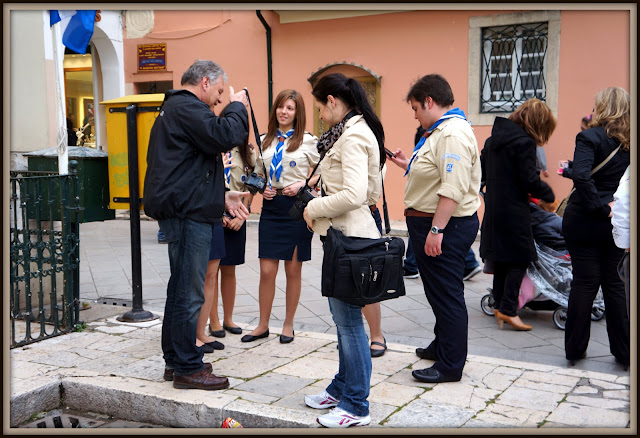Az ortodox vallás legfontosabb ünnepe a Húsvét. A Nagypénteki körmenet, Krisztus szimbolikus temetése pedig ennek az egyik legfontosabb mozzanata. Korfu város sok hívet és érdeklődőt vonz ezen a napon, nem csoda, hiszen összesen 33 díszes körmenet vonul végig az Óváros utcáin. Az ünnepi mise után, filharmonikus zenekar kíséretében elindul a virágokkal feldíszített szimbolikus koporsó, az Epitáfiosz, majd a Listont megkerülve újra megérkezik a kiindulási pontra. A filharmonikusokon kívül énekkarok, kultúr- és egyéb egyesületek, a vöröskereszt tagjai, a cserkész szövetség, a helyi politikai elit tagjai is felvonulnak. Az első körmenet két órakor indul az Új Erődben található templomból, míg az utolsó este tíz órakor a Spilia városrészben található székesegyházból.
Az idei húsvéthoz borongós, esős időjárás társult, így a Nagypénteknek is valódi gyászos hangulatot kölcsönzött. A korfui Húsvét országszerte híres, évente több ezer látogató érkezik, hogy részesei legyenek a több száz éves tradicóknak, melyek a bizánci, a velencei és a nyugati hagyományok harmonikus kereszteződése.
***
The most important feast of the Orthodox religion is Easter. The Good Friday procession, Christ's symbolic funeral is one of it's key elements. Corfu town attracts many believers and visitors in these days, no wonder, in total there are 33 magnificent processions passing through the streets of the Old Town. After the festive mass, the symbolic coffin of Jesus, the Epitaphios, decorated with flowers, accompanied by a philharmonic orchestra is leaving from the church, get around the Liston (or different points of the town) and arriving back to the church. Beyond the philharmonic orchistras choirs, cultural and other associations, members of the Red Cross, the Scout Association, the local political elite also are taking part in the procession. The first procession starts two o'clock from the church located in the New Fortress, and the last at ten o'clock from the cathedral church in the Spilia district. The Easter this year was associated with gloomy and rainy weather, so that borrowed to Good Friday a real sad feeling. Easter in Corfu is famous throughout the country, thousands of visitors arrive each year to become part of the traditions, which are harmonious mixture of the byzantine, venetian and western traditions.
The most important feast of the Orthodox religion is Easter. The Good Friday procession, Christ's symbolic funeral is one of it's key elements. Corfu town attracts many believers and visitors in these days, no wonder, in total there are 33 magnificent processions passing through the streets of the Old Town. After the festive mass, the symbolic coffin of Jesus, the Epitaphios, decorated with flowers, accompanied by a philharmonic orchestra is leaving from the church, get around the Liston (or different points of the town) and arriving back to the church. Beyond the philharmonic orchistras choirs, cultural and other associations, members of the Red Cross, the Scout Association, the local political elite also are taking part in the procession. The first procession starts two o'clock from the church located in the New Fortress, and the last at ten o'clock from the cathedral church in the Spilia district. The Easter this year was associated with gloomy and rainy weather, so that borrowed to Good Friday a real sad feeling. Easter in Corfu is famous throughout the country, thousands of visitors arrive each year to become part of the traditions, which are harmonious mixture of the byzantine, venetian and western traditions.
 |
A városközpont az ünnepi események ideje alatt autóval megközelíthetetlen
The city center is inaccessible by car during the festive events
|
 |
| Mindenki a belváros felé igyekszik Everyone is moving towards city center |
 |
| Hamarosan felgyúlnak a lila színű égők (a gyászt jelképezi) The purple bulbs will light up soon (a symbol of mourning) |
 |
| A cserkészek is jelen vannak The scouts are also taking part |
 |
| Az egyik körmenet One of the processions |
 |
| A katolikus székesegyház- innen 21:00 órakor indul a gyászmenet The Catholic Church (Duomo)- from here the funeral procession starts 21:00 o'clock |
 |
| A katolikus templombelső The catholic church from inside |
Another procession accompanied by the "Old" Philharmonic Orchestra
 |
| A katolikus körmenet The catholic procession |
 |
| Nagypénteki mise a Szent Szpiridon templomban Good Friday Mass at the Church of St. Spyridon |
 |
| A Szent Szpiridon templom előtt Outside of the St. Spyridon church |
 |
| A Panagia ton Xenon templom "epitáfiosz"-a The epitaphios of the Panagia ton Xenon church |
 |
| A körmenet után a hívők fejet hajtanak a szimbolikus koporsó előtt After the procession believers are bowing head in front of the symbolic coffin |
 |
| A korfui székesegyház, az utolsó körmenet innen, este tíz órakor indul The Orthodox Cathedral in Corfu town, the last procession starts from here at ten o'clock in the evening |
Indul a körmenet
The procession starts
 |
| A láng kézről kézre jár The flame passed from hand to hand |
 |
| A híres lila fények a Lisztonon The famous violet-colored lights on the Liston |



















































